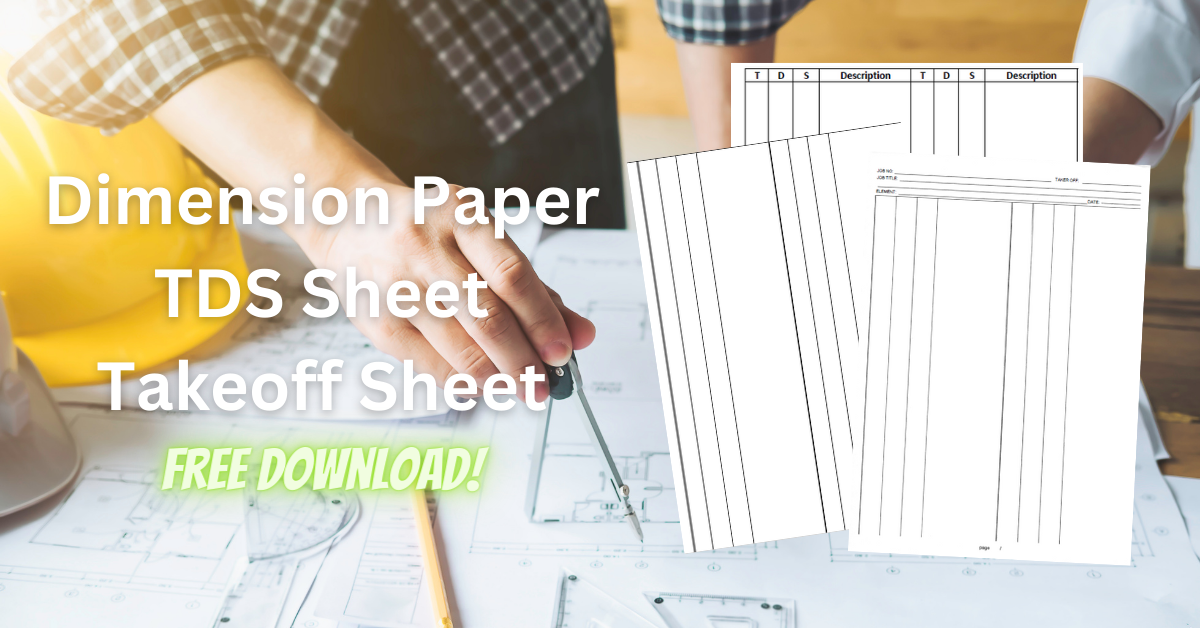Introduction
Imagine constructing a building without accurate measurements and calculations. The results would be catastrophic—a chaotic mess of mismatched materials, unanticipated costs, and compromised structural integrity. In the world of construction, precision is paramount. That’s where dimension paper comes into play. This specialized paper, with its unique features and purpose, serves as a reliable companion for quantity surveyors, building estimators, and engineers. In this article, we will delve into the significance of dimension paper and explore its applications in the fields of quantity surveying, building estimation, and engineering.
What is Dimension Paper?
At its core, dimension paper is a specialized tool designed to facilitate accurate measurements and calculations in construction-related professions. It is a grid-based paper with predefined spacing and layout that aids professionals in recording and organizing precise dimensions, quantities, and other essential data. Think of it as a trusty canvas upon which the intricate details of a construction project are meticulously captured.
Similar Names
Dimension paper is typically printed in A4 portrait format. There are several names for this sheet.
- Dimension paper
- TDS Sheet
- Takeoff Sheet
You can download following sample dimension papers.
Features and Purpose
Dimension paper boasts several key features that make it an invaluable asset in construction-related professions:
- Grid Structure: The paper is adorned with a fine grid pattern, typically in millimeters or inches, creating a structured framework for measurements. This grid acts as a visual guide, enabling professionals to record dimensions with remarkable precision.
- Logical Sequencing: Dimension paper incorporates sequential numbering or lettering, allowing dimensions to be entered in a logical order. This logical sequencing aids in understanding and interpreting the recorded information efficiently.
- Clear Spacing: Adequate spacing between the grid lines ensures legibility and prevents the cluttering of dimensions. Neatness and clarity are crucial for effective communication and comprehension of the recorded data.
The purpose of dimension paper is twofold: to provide a consistent, organized platform for recording measurements and to facilitate accurate calculations and estimations based on those measurements.
Applications in Quantity Surveying, Building Estimation, and Engineering
Now that we understand the essence of dimension paper, let’s explore its significance and applications in the fields of quantity surveying, building estimation, and engineering. Brace yourself for a journey through the intricacies of these professions, where dimension paper acts as a reliable guide.
Quantification Process: From Drawings to Takeoff Sheet
The quantification process, often referred to as “taking off,” is a fundamental task in quantity surveying, building estimation, and engineering. It involves extracting dimensions and quantities from architectural and engineering drawings and meticulously recording them on dimension paper. This process sets the foundation for accurate cost estimation, material procurement, and construction planning.
Measuring Building Work: Accuracy and Future Reference
Accurate and well-presented quantities play a pivotal role in reducing errors, aiding future reference, and facilitating smooth project execution. Through dimension paper, quantity surveyors and building estimators ensure that every nut, bolt, and beam is accounted for. This meticulous quantification not only helps in evaluating project costs but also assists in scheduling construction activities and maintaining quality control.
Hand-Written Taking Off: A Consulting Quantity Surveying Technique
In consulting quantity surveying practices, a hand-written taking off approach is often employed, where the dimensions are manually recorded on dimension paper. This method, though time-consuming, offers a tangible connection to the project and allows for detailed analysis. It demands meticulous attention to detail and ensures a thorough understanding of the project’s intricacies.
Preparing Tender Documents: Measurements and Computations
Dimension paper plays a vital role in preparing tender documents, which serve as blueprints for construction contracts. Measurements recorded on dimension paper are meticulously taken to the nearest 10mm, booked in meters to two decimal places, and computed using multipliers and squaring techniques. This rigorous methodology ensures accuracy and precision in the estimation of quantities.
Clarity, Logic, and Technical Accuracy
In the realm of construction, clarity is key. Dimension paper facilitates the clear presentation and effective communication of measurements. Annotating dimensions, performing preliminary dimension calculations, and entering dimensions in a logical sequence on the paper are essential steps that contribute to accuracy and seamless interpretation. Through these practices, professionals ensure that the dimensions make sense and form a coherent picture of the construction project.
Neatness and Grouping: The Art of Presentation
Like an artist’s canvas, dimension paper demands a sense of aesthetics and presentation. Neatness, adequate spacing, and grouping of dimensions are crucial aspects that enhance the legibility and visual appeal of the recorded data. The meticulous arrangement of dimensions on dimension paper ensures that professionals can swiftly interpret and utilize the information during various stages of the project.
Enhancing Accuracy, Clarity, and Communication
Dimension paper serves as a conduit for accuracy, clarity, and effective communication in the quantification process. By providing a structured framework and clear organization, dimension paper empowers professionals to record, analyze, and share critical project information. It serves as a visual representation of the project’s dimensions and quantities, enabling stakeholders to make informed decisions and collaborate seamlessly.
The Metaphor of Dimension Paper
To better grasp the significance of dimension paper, let’s employ a metaphor. Imagine a construction project as a complex puzzle. The pieces of this puzzle are the dimensions, quantities, and calculations. It acts as the puzzle board, where these pieces come together in perfect alignment. Without this board, the puzzle would remain disjointed and incomplete. Dimension paper unifies the dimensions, just as the puzzle board unifies the pieces, creating a coherent whole that transforms chaos into order.
Overcoming Challenges and Misconceptions
As with any specialized tool, Take of sheets comes with its own set of challenges and misconceptions. Some may argue that digital tools and software have rendered dimension paper obsolete. However, the tactile nature of dimension paper offers a tangible connection to the project, fostering a deeper understanding and facilitating meticulous analysis. Challenges such as handling large-scale projects or managing changes can be overcome through systematic approaches, diligent record-keeping, and adaptability.
Real-World Examples
Dimension paper has proven its worth in numerous real-world projects. In the construction of a high-rise building, It was instrumental in accurately quantifying the materials required, streamlining the procurement process, and ensuring timely completion. In infrastructure projects like bridges and highways, It played a crucial role in calculating the quantities of concrete, steel, and other materials needed for construction. These examples highlight the practical applications and benefits of dimension paper in various domains of construction.
Conclusion
In the world of quantity surveying, building estimation, and engineering, precision and accuracy reign supreme. Dimension paper, with its grid structure, logical sequencing, and clear spacing, serves as a faithful companion to professionals in these fields. It enables the meticulous recording of dimensions, facilitates accurate calculations, and enhances clarity and communication. From hand-written taking off to tender document preparation, dimension paper acts as a bridge, connecting the abstract world of architectural drawings to the tangible realm of construction. As we conclude our exploration, let us recognize the profound value of dimension paper, a seemingly simple tool that plays a pivotal role in shaping our built environment.
Frequently Asked Questions
- Is TDS sheets still relevant in the era of digital tools and software? Absolutely! While digital tools offer convenience, It provides a tactile connection to the project and fosters a deeper understanding of the dimensions and quantities involved.
- Can dimension paper handle large-scale projects? Dimension paper is adaptable to projects of all sizes. By using multiple sheets or larger dimensions on a single sheet, professionals can effectively manage and record measurements for large-scale projects.
- How can I ensure accuracy when using dimension paper? Accuracy is achieved through meticulous measurement and recording. Double-checking dimensions, performing calculations with care, and maintaining a logical sequencing of entries on dimension paper are essential for accuracy.
- Are there any specific techniques for handling changes in dimensions during a project? To handle changes in dimensions, it is important to maintain clear documentation of revisions and updates. Adding annotations and cross-referencing changes on dimension paper can help ensure accurate and up-to-date measurements.
- Are there alternatives to dimension paper for recording measurements? While This is a widely used and trusted tool, alternatives such as grid-lined notebooks or specialized software can also be utilized. However, it is important to ensure that any alternative provides the necessary structure and clarity for accurate measurements and calculations.









